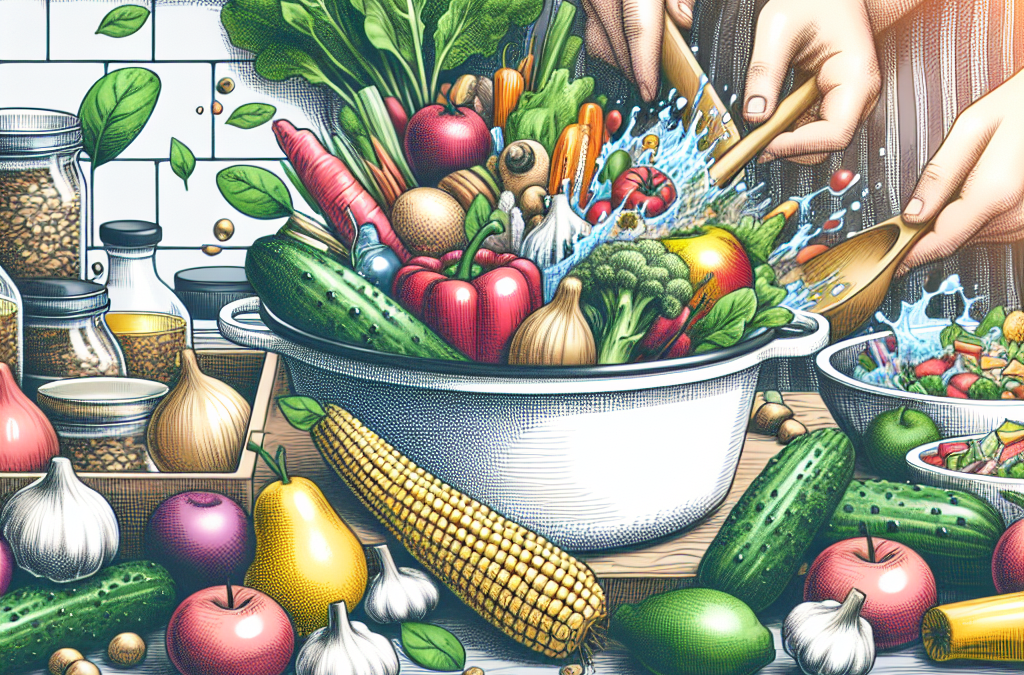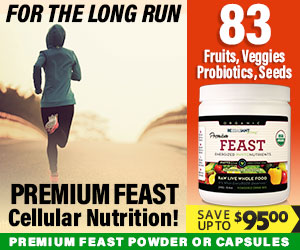1. Choosing the Right Ingredients
Freshness Matters
When I head to the grocery store or farmer’s market, one thing I’ve learned is that freshness is key. Whole foods lose their nutrients over time. So, I always try to pick items that look vibrant and have a short shelf life. If you can, ask the vendors or shopkeepers when the food was harvested. Trust me, it makes a difference!
Also, consider organic options if they’re accessible. They often have higher nutrient content because they’re grown without the harsh chemicals that can inhibit nutrient absorption. It’s worth investing a bit more for your health in the long run.
Lastly, I always remember to check for any signs of spoilage. Bruises, wilted leaves, or unusual odors? Nope! I simply pass those by, knowing my body deserves the best.
Variety is Key
In my kitchen, variety isn’t just the spice of life; it’s the foundation of a well-rounded diet. Different colors and types of foods provide different nutrients. I always try to fill my cart with a rainbow of produce. Not only does it look beautiful on the plate, but it ensures I’m getting a broad spectrum of vitamins and minerals.
For example, leafy greens are a superfood, but incorporating sweet potatoes, berries, and nuts every week helps keep my meals interesting and nutritious. Think of it like assembling a superhero team for your health!
Even proteins and grains can be mixed up; chickpeas, quinoa, and lentils have unique benefits. So, branching out from your usual staples can significantly enhance your nutritional intake!
Know Your Food
I’ve found that understanding the foods I eat can make a world of difference! Each food comes packed with specific nutrients. Some foods work better together, amplifying their health benefits. Did you know that pairing vitamin C-rich foods with iron sources can help your body absorb the iron better? That’s a combo I always keep in mind!
Also, while cooking, some nutrients can be lost—I’m looking at you, Vitamin C in veggies! Learning about each ingredient’s optimal cooking methods has been a game-changer for me. Steaming over boiling? Yes, please!
Lastly, I’ve become quite the label reader. Understanding what’s in my food and how it’s processed helps me steer clear of hidden sugars and preservatives that can sneak into my meals.
2. Preparing Foods Correctly
Cutting Techniques
Let’s talk about chopping! The way we cut our produce can significantly impact nutrient retention. I used to hack away at my veggies without a second thought, but I’ve switched to more gentle techniques like slicing or dicing neatly. This helps minimize nutrient loss and keeps everything looking sharp on the plate!
Moreover, I’ve discovered that cutting fruits and veggies just before cooking or eating can help keep those vitamins intact. If you’re prepping ahead of time, keep them whole until you’re ready to enjoy them.
Remember, the sharper the knife, the cleaner the cut. A clean cut reduces cellular damage, helping to keep those nutrients packed in. So, don’t forget to give your knives a little love!
Cooking Methods
There’s so much to explore when it comes to cooking methods! I used to think boiling was my only option, but I’ve since learned that methods like steaming or sautéing can preserve more nutrients. Steaming is gentle and keeps more vitamins in the food compared to boiling where nutrients leach into the water.
Roasting, grilling, and even microwaving (yes, really!) can also be fantastic options. They can enhance flavor and texture while maintaining that nutrient profile. I’ve found that experimenting with these methods has made me look at my meals in a new light.
Plus, don’t forget about the power of raw foods! I’ve started incorporating more salads and fresh dishes because some nutrients are better absorbed when we eat food raw. It’s all about balance and trying new things!
Timing Your Meals
Let’s touch on timing! I’ve learned that when I eat can also influence nutrient absorption. Eating certain foods together can create a synergy that boosts nutritional benefits. For example, having fats like olive oil with vegetables can help absorb fat-soluble vitamins!
Also, it’s vital to listen to your body. If you’re feeling sluggish after a heavy meal, I suggest spacing out meals throughout the day. Smaller, balanced meals can enhance energy and nutrient uptake.
Finally, don’t rush your meals! Taking time to chew can really help with digestion and nutrient absorption. I make it a point to slow down, savor flavors, and engage with my food—as it should be an enjoyable experience!
3. Incorporating Healthy Fats
Know Your Fats
When I dive into the world of fats, it’s essential to know the difference between the good, the bad, and the ugly. Healthy fats—like those from avocados, olive oil, nuts, and seeds—are my besties when it comes to nutrient absorption. They help transport vitamins and nutrients safely throughout my body.
I’ve also learned to steer clear of trans fats and overly processed oils. These do more harm than good and can hinder my nutrition goals. I always check labels and choose whole, unprocessed sources whenever I can!
Remember to share the love among the fat types—omega-3s, omega-6s, and the monounsaturated varieties all play their roles, so I make sure to get a good mix.
Cooking with Fats
In my cooking, I always incorporate those healthy fats. Whether it’s drizzling olive oil on my salad or adding nuts to a stir-fry, I’m all in! Another fun tip? Cooking with fats can enhance the flavor of your food, encouraging you to enjoy those nutritious ingredients even more!
I also ensure that when I’m cooking my veggies, fats like coconut oil or avocado oil can help with that nutrient absorption. It’s a win-win—I get super tasty meals while also enhancing their nutritional value. Now, who wouldn’t want that?
Get an Amazing Discount on the Best Certified Organic Whole Food Supplement!
And don’t forget about the power of nut butters! Tossing a spoonful into smoothies or oatmeal can add creaminess and boost nutrient absorption in a delicious way.
Combining Foods
One of my favorite tricks is food pairing—combining specific ingredients for optimal absorption! For instance, I always pair my leafy greens with nuts or seeds, as the fats can help my body absorb all those great vitamins that greens have to offer.
Another delightful combination is tomatoes with olive oil; this duo increases the absorption of lycopene, a powerful antioxidant. I love playing around with my meals to discover fun and nutritious combinations!
Even breakfast can be a nutrient goldmine! A slice of whole grain toast topped with avocado and sun-dried tomatoes? Yes, please! By experimenting with different food combinations, I’ve brought a whole new level of enjoyment and health to my meals.
4. Managing Food Storage
Best Practices for Freshness
When it comes to food storage, I’ve learned that how I store my food can make or break nutrient retention. I keep most fruits and veggies in the fridge to slow down spoilage. Some might be surprised to know that not all foods belong there, though! Tomatoes and bananas are happier on the counter.
I also use airtight containers for items like nuts and seeds to protect them from air and moisture, which can cause them to lose valuable nutrients. It’s all about giving my food the best chance to stay fresh and nutrient-rich!
Finally, I’ve turned to meal prep as a way to keep my food game strong. Portioning out meals for the week not only saves time but also helps me avoid waste.
Freezing for Later
Sometimes I can’t eat everything at once, and that’s where freezing comes into play. I love freezing fruits and veggies to keep their nutrients locked in. I’ve found that blanched veggies freeze wonderfully ’cause it helps maintain their color and texture. Sounds good, right?
Freezing also means I can stockpile my favorite seasonal produce for later. I love tossing frozen berries in my morning smoothie; they’re just as good as fresh!
Just remember, when you thaw, do it gently to keep those nutrients intact. And keep an eye on how long things have been frozen; they can lose nutrients over time if stored too long.
Avoiding Spoilage
Spoilage is a real bummer, and it’s something I actively try to avoid. I always practice the “first in, first out” method; using older items first before the fresh ones. It helps minimize waste and keeps me on top of what I’ve got.
Another tip is to regularly check my pantry and fridge for anything that might be lurking and past its prime. If I see something starting to wilt or spoil, I’ll get creative and incorporate it into my meals soon!
It’s all about being proactive—by managing storage and avoiding spoilage, I’m ensuring that I’m getting the most out of the nutrient-packed foods I invest in.
5. Understanding Your Body’s Needs
Listen to Your Body
I can’t stress enough how important it is to listen to what my body is telling me. Everyone’s nutritional needs can be different. For me, it’s about tuning into how various foods make me feel. Certain foods energize me, while others might make me sluggish.
I’ve started paying attention to which foods help me feel vibrant and satisfied. Personalizing my choices for what works best for my body has taken my nutrient absorption game to the next level.
Also, recognizing signs of deficiencies is crucial. Fatigue, hair loss, or skin issues are clear indicators that something might be off. If I suspect something’s not right, I consult with my healthcare provider to ensure my nutrient needs are met.
Nutrition Education
Let’s face it; there’s a ton of information out there, and it can get overwhelming. But I love learning about nutrition! The more I dive into topics regarding whole foods and nutrient absorption, the more equipped I feel to make better choices.
Online resources, workshops, and even cookbooks have helped shape my understanding of how food affects my health. I’ve come to realize that I can always gain something new, and I try to share what I learn with friends and family.
It’s all about building a knowledge base—knowing what works best for my lifestyle and health goals. I encourage others to seek out information that helps clarify and inspire them too!
Being Mindful
Practicing mindfulness around food is something I cherish. Understanding how the foods I choose impact my body, mood, and energy levels helps me create healthier connections with what I consume. When I eat, I make it a point to focus fully on my meal—savoring flavors and textures without distractions.
I’ve also adopted mindful cooking techniques. Experimenting with new recipes and paying attention to the process has made preparing meals feel more like a joy than a chore. The whole experience has turned into something relaxing for me.
At the end of the day, nourishing my body is a holistic experience—from choosing foods to how I digest them. It’s about creating a positive relationship with what fuels me every day.
FAQ
- 1. What are whole foods?
- Whole foods are foods that are minimally processed and free from additives. This includes fruits, vegetables, whole grains, nuts, seeds, and legumes.
- 2. How can I improve nutrient absorption in my diet?
- You can improve nutrient absorption by choosing fresh and whole ingredients, cooking them properly, combining certain foods, and incorporating healthy fats.
- 3. Are there specific cooking methods that retain more nutrients?
- Steaming and sautéing are great methods for retaining nutrients. Avoid boiling whenever possible, as it can cause vitamins to leach into the cooking water.
- 4. Why is variety in my food choices important?
- Different foods provide different nutrients. A variety of colorful fruits and vegetables can help ensure that you’re getting a well-rounded intake of vitamins and minerals.
- 5. How can I store whole foods to maintain their nutrients?
- Store foods in cool, dark places or the fridge to slow spoilage. Use airtight containers and consider freezing for longer storage while retaining nutrients.




